
Alexander Franklin James was a Confederate soldier and guerrilla; in the post-Civil War period, he was an outlaw. The older brother of outlaw Jesse James, Frank was also part of the James–Younger Gang.
Gunfighters, also called gunslingers, or in the late 19th and early 20th century, gunmen were individuals in the American Old West who gained a reputation of being dangerous with a gun and participated in gunfights and shootouts. Today, the term "gunslinger" is more or less used to denote someone who is quick on the draw with a handgun, but this can also refer to those armed with rifles and shotguns. The gunfighter is also one of the most popular characters in the Western genre and has appeared in associated films, television shows, video games, and literature.

Alan Hale Jr. was an American actor and restaurateur. He was the son of actor Alan Hale Sr. His television career spanned four decades, but he was best known for his secondary lead role as Captain Jonas Grumby, better known as The Skipper, on the 1960s CBS comedy series Gilligan's Island (1964–1967), a role he reprised in three Gilligan's Island television films and two spin-off cartoon series.
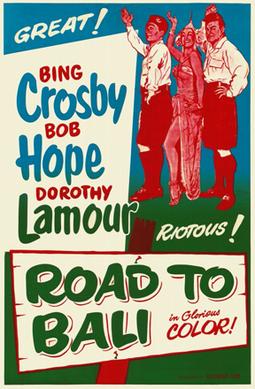
Road to Bali is a 1952 American comedy film directed by Hal Walker and starring Bing Crosby, Bob Hope, and Dorothy Lamour. Released by Paramount Pictures on November 19, 1952, the film is the sixth of the seven Road to … movies. It was the only entry in the series filmed in Technicolor and was the first to feature surprise cameo appearances from other well-known stars of the day.

Rhonda Fleming was an American film and television actress and singer. She acted in more than 40 films, mostly in the 1940s and 1950s, and became renowned as one of the most glamorous actresses of her day, nicknamed the "Queen of Technicolor" because she photographed so well in that medium.

Gunfight at the O.K. Corral is a 1957 American Western film starring Burt Lancaster as Wyatt Earp and Kirk Douglas as Doc Holliday, and loosely based on the actual event in 1881. The film was directed by John Sturges from a screenplay written by novelist Leon Uris. It was a remake of the 1939 film Frontier Marshall starring Randolph Scott, which was until 1957 the definitive film of the gunfight story.

My Favorite Brunette is a 1947 American romantic comedy film and film noir parody, directed by Elliott Nugent and starring Bob Hope and Dorothy Lamour. Written by Edmund Beloin and Jack Rose, the film is about a baby photographer on death row in San Quentin State Prison who tells reporters his history. While taking care of his private-eye neighbor's office, he is asked by an irresistible baroness to find a missing baron, which initiates a series of confusing but sinister events in a gloomy mansion and a private sanatorium. Spoofing movie detectives and the film noir style, the film features Lon Chaney Jr. playing Willie, a character based on his Of Mice and Men role Lennie; Peter Lorre as Kismet, a comic take on his many film noir roles; and cameo appearances by film noir regular Alan Ladd and Hope partner Bing Crosby. Sequences were filmed in San Francisco and Pebble Beach, California.

Robert Newton Ford was an American outlaw who killed fellow outlaw Jesse James on April 3, 1882. He and his brother Charley, both members of the James–Younger Gang under James's leadership, went on to perform paid re-enactments of the killing at publicity events. Ford would spend his later years operating multiple saloons and dance halls in the West.

Donald Barry de Acosta, also known as Red Barry and Milton Poimboeuf, was an American film and television actor. He was nicknamed "Red" after appearing as the first Red Ryder in the highly successful 1940 film Adventures of Red Ryder with Noah Beery Sr.; the character was played in later films by "Wild Bill" Elliott and Allan Lane. Barry went on to bigger budget films following Red Ryder, but none reached his previous level of success. He played Red Doyle in the 1964 Perry Mason episode "The Case of the Simple Simon".
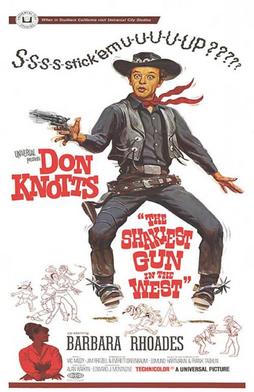
The Shakiest Gun in the West is a 1968 American comedy Western film starring Don Knotts. It was directed by Alan Rafkin and written by Jim Fritzell and Everett Greenbaum. The film is a remake of The Paleface, a 1948 film starring Bob Hope and Jane Russell.

The Outlaws Is Coming is the sixth and final theatrical comedy starring The Three Stooges after their 1959 resurgence in popularity. By this time, the trio consisted of Moe Howard, Larry Fine, and Joe DeRita. Like its predecessor, The Three Stooges Go Around the World in a Daze, the film was co-written, produced and directed by Moe's son-in-law, Norman Maurer. The supporting cast features Adam West, Nancy Kovack, and Emil Sitka, the latter in three roles.

This is a selection of films and television appearances by British-American comedian and actor Bob Hope (1903-2003). Hope, a former boxer, began his acting career in 1925 in various vaudeville acts and stage performances

The Savage Guns is a 1961 Eurowestern film, an international co-production by British and Spanish producers. Based on a specially commissioned screenplay, The San Siado Killings, written by Peter R. Newman and directed by Michael Carreras, the film is credited as the first traditional Spaghetti Western.

Gun the Man Down is a 1956 American western film directed by Andrew V. McLaglen and starring James Arness and Angie Dickinson in her first leading role. The film was produced by Robert E. Morrison for his brother John Wayne's company Batjac Productions. It was the second theatrical feature directed by McLaglen, who was a prolific director of television westerns.
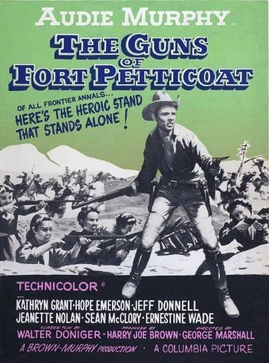
The Guns of Fort Petticoat is a 1957 American Western film produced by Harry Joe Brown and Audie Murphy for Brown-Murphy Pictures. It was based on the 1955 short story "Petticoat Brigade" by Chester William Harrison (1913–1994) that he expanded into a novelization for the film's release. It was directed by George Marshall, distributed by Columbia Pictures and filmed at the Iverson Movie Ranch and at Old Tucson.

Gunfight at Comanche Creek is a 1963 American Western film directed by Frank McDonald and starring Audie Murphy.
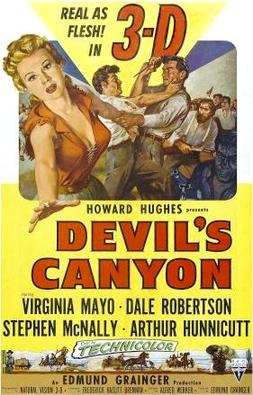
Devil's Canyon is a 1953 American Western 3-D film directed by Alfred L. Werker. The film stars Virginia Mayo, Dale Robertson, Stephen McNally and Arthur Hunnicutt.
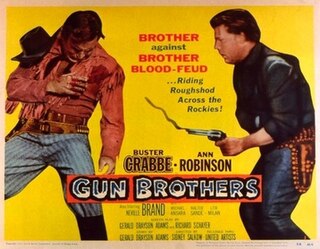
Gun Brothers is a 1956 American western film directed by Sidney Salkow and starring Buster Crabbe, Ann Robinson and Neville Brand. It was Crabbe's first feature film in six years.
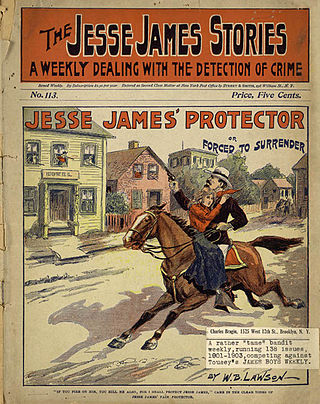
Cultural depictions of Jesse James appear in various types of media, including literature, video games, comics, music, stage productions, films, television, and radio. James is variously described as an American outlaw, bank and train robber, guerrilla, and leader of the James–Younger Gang. After the American civil war, as members of various gangs of outlaws, Jesse and Frank James robbed banks, stagecoaches, and trains across the Midwest, gaining national fame and even sympathy despite their crimes. James became an iconic figure from the era, and his life has been dramatized and memorialized numerous times.
Rexford George Holman is an American film and television actor.

















